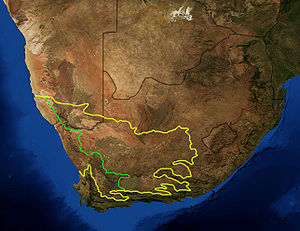
Succulent Karoo
Encyclopedia

Deserts and xeric shrublands
Deserts and xeric shrublands is a biome characterized by, relating to, or requiring only a small amount of moisture.-Definition and occurrence:...
ecoregion of South Africa
South Africa
The Republic of South Africa is a country in southern Africa. Located at the southern tip of Africa, it is divided into nine provinces, with of coastline on the Atlantic and Indian oceans...
and Namibia
Namibia
Namibia, officially the Republic of Namibia , is a country in southern Africa whose western border is the Atlantic Ocean. It shares land borders with Angola and Zambia to the north, Botswana to the east and South Africa to the south and east. It gained independence from South Africa on 21 March...
.
Setting
The Succulent Karoo stretches along the coastal strip of southwestern Namibia and South Africa's Northern Cape Province, where the cold Benguela CurrentBenguela Current
The Benguela Current is the broad, northward flowing ocean current that forms the eastern portion of the South Atlantic Ocean gyre. The current extends from roughly Cape Point in the south, to the position of the Angola-Benguela Front in the north, at around 16°S. The current is driven by the...
offshore creates frequent fogs. The ecoregion extends inland into the uplands of South Africa's Western Cape Province. It is bounded on the south by the Mediterranean climate
Mediterranean climate
A Mediterranean climate is the climate typical of most of the lands in the Mediterranean Basin, and is a particular variety of subtropical climate...
fynbos
Fynbos
Fynbos is the natural shrubland or heathland vegetation occurring in a small belt of the Western Cape of South Africa, mainly in winter rainfall coastal and mountainous areas with a Mediterranean climate...
, on the east by the Nama Karoo, which has more extreme temperatures and variable rainfall, and on the north by the Namib Desert
Namib Desert
The Namib Desert is a desert in Namibia and southwest Angola that forms part of the Namib-Naukluft National Park, the largest game reserve in Africa. The name "Namib" is of Nama origin and means "vast place"...
.
Flora
The Succulent Karoo is notable for the world's richest flora of succulent plantSucculent plant
Succulent plants, also known as succulents or fat plants, are water-retaining plants adapted to arid climates or soil conditions. Succulent plants store water in their leaves, stems, and also in roots...
s, and harbors about one-third of the world’s approximately 10,000 succulent species. The region is also extraordinarily rich in geophytes, harboring approximately 630 species.
Fauna
The ecoregion is a center of diversity and endemism for reptileReptile
Reptiles are members of a class of air-breathing, ectothermic vertebrates which are characterized by laying shelled eggs , and having skin covered in scales and/or scutes. They are tetrapods, either having four limbs or being descended from four-limbed ancestors...
s and many invertebrate
Invertebrate
An invertebrate is an animal without a backbone. The group includes 97% of all animal species – all animals except those in the chordate subphylum Vertebrata .Invertebrates form a paraphyletic group...
s. Of the ecoregion’s 50 scorpion
Scorpion
Scorpions are predatory arthropod animals of the order Scorpiones within the class Arachnida. They have eight legs and are easily recognized by the pair of grasping claws and the narrow, segmented tail, often carried in a characteristic forward curve over the back, ending with a venomous stinger...
species, 22 are endemic. Monkey beetle
Monkey beetle
Monkey beetles are a group of scarab beetles, comprising the subfamily Rutelinae, and are placed within the tribe Hopliini. Many species visit flowers for pollen and nectar, or browse on the petals.-Overview:...
s, largely endemic to southern Africa, are concentrated in the Succulent Karoo and are important pollinator
Pollinator
A pollinator is the biotic agent that moves pollen from the male anthers of a flower to the female stigma of a flower to accomplish fertilization or syngamy of the female gamete in the ovule of the flower by the male gamete from the pollen grain...
s of the flora. So, too, are the Hymenoptera
Hymenoptera
Hymenoptera is one of the largest orders of insects, comprising the sawflies, wasps, bees and ants. There are over 130,000 recognized species, with many more remaining to be described. The name refers to the heavy wings of the insects, and is derived from the Ancient Greek ὑμήν : membrane and...
and masarine wasps, and colletid, fideliid, and melittid bees.
Approximately 15 amphibian
Amphibian
Amphibians , are a class of vertebrate animals including animals such as toads, frogs, caecilians, and salamanders. They are characterized as non-amniote ectothermic tetrapods...
s are found in this ecoregion, including three endemics; among the region’s 115 reptile species, 48 are endemic and 15 are strict endemics. The Sperregebiet region is a hotspot for an unusual tortoise, the Namba padloper. Endemism is present, but less pronounced, among the Succulent Karoo’s bird
Bird
Birds are feathered, winged, bipedal, endothermic , egg-laying, vertebrate animals. Around 10,000 living species and 188 families makes them the most speciose class of tetrapod vertebrates. They inhabit ecosystems across the globe, from the Arctic to the Antarctic. Extant birds range in size from...
and mammal
Mammal
Mammals are members of a class of air-breathing vertebrate animals characterised by the possession of endothermy, hair, three middle ear bones, and mammary glands functional in mothers with young...
populations.
Conservation
The ecoregion has been designated a biodiversity hotspotBiodiversity hotspot
A biodiversity hotspot is a biogeographic region with a significant reservoir of biodiversity that is under threat from humans.The concept of biodiversity hotspots was originated by Norman Myers in two articles in “The Environmentalist” , revised after thorough analysis by Myers and others in...
by Conservation International
Conservation International
Conservation International is a nonprofit organization headquartered in Arlington, Virginia, which seeks to ensure the health of humanity by protecting Earth's ecosystems and biodiversity. CI’s work focuses on six key initiatives that affect human well-being: climate, food security, freshwater...
.

